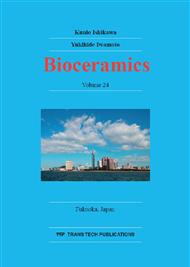p.153
p.157
p.161
p.167
p.173
p.178
p.183
p.187
p.192
In Vitro Biological Evaluation of Anti-Tumor Effect of the Chelate-Setting Hydroxyapatite Cement
Abstract:
Cancers frequently metastasize to bone, where it leads to secondary tumor growth, and osteolytic bone degradation. Bone metastases are often associated with fractures and severe pain resulting in decreased quality of life. Accordingly, effective therapies to inhibit the development or progression of bone metastases will have important clinical benefits. Bone cement, one of the powerful tools as bone substitutes, is used to fill the resection voids. The aim of this study was to develop a local drug delivery system using HAp cement as a carrier of chemotherapeutic agents. In the present study, we have fabricated chelate-setting apatite cements (IP6-HAp cements) using HAp particles surface-modified with inositol hexaphosphate (IP6) and evaluated their anti-tumor effect. Human osteosarcoma (HOS) cultured on IP6-HAp cements (over 3000 ppm IP6) resulted in inhibition of cell growth. DNA microarray analysis indicated changes in the expression of apoptosis-related genes on IP6-HAp cement surface-modified with 5000 ppm IP6 compared with HAp cement, suggesting activation of apoptosis machinery by IP6-HAp cement. To clarify the mechanism of anti-tumor effect of IP6-HAp cement, the properties of cement were investigated. The release kinetics of IP6 from IP6-HAp cement showed that the level of released IP6 was insufficient to induce anti-tumor activity. These results led us to consider that locally high concentration of IP6 which was released from cement acts on the cells directly as anti-tumor agent and induces the apoptosis. Consequently, IP6-HAp cement might gain the anti-tumor effect and act as a carrier for local drug delivery system.
Info:
Periodical:
Pages:
173-177
Citation:
Online since:
November 2012
Authors:
Keywords:
Price:
Сopyright:
© 2013 Trans Tech Publications Ltd. All Rights Reserved
Share:
Citation:


